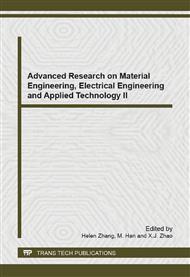[1]
Fan Ruimin, Hu Yuxin, Qiao Xin. Lightning protection research of Large passenger aircraft[J]. Jiangsu Aviation, 2010, 1: 10-11.
Google Scholar
[2]
Wu Zhien. Protection against lightning of aircraft composite components[J]. Aeronautical Manufacturing Technology, 2011, 15: 97-99.
Google Scholar
[3]
Zhu Yisheng Application of fiber materials in aviation industry. Synthetic Fiber, 2009, 4: 1-4.
Google Scholar
[4]
Ji Chaohui, Ma Qianqian, Wang Zhiping, et al. Design and application of lightning protection layer of airplane composite materials[J]. Aerospace Materials & Technology, 2010, 5: 50-54.
Google Scholar
[5]
Wen Hao, Wang Hong. Research and analysis on the lightning test of aircraft model[J]. High Voltage Apparatus, 2011, 47(7): 104-107.
Google Scholar
[6]
Zhao Yulong, Liu Guangbin, Yu Zhiyong. Research on lightning attachment points simulation for aircraft[J]. Journal of Microwaves, 2012, 28(4): 39-42.
Google Scholar
[7]
Xiong Xiu, Luo Lifeng, Fan Xiaoyu, et al. The direct effects of lightning on aircraft[J]. Aircraft Design, 2011, 31(4): 64-68.
Google Scholar
[8]
Guo Yong. Direct and indirect effects test of aircraft[D]. Cheng Du: University of Electronic Science and Technology of China, (2007).
Google Scholar
[9]
Ogasawara T,Hirano Y,Yoshimura A,et al. Coupled thermal-electrical analysis for carbon fiber/epoxy composites exposed to simulated lighting current. Composites Part A: Applied Science and manufacturing,2010,41(8):973-981.
DOI: 10.1016/j.compositesa.2010.04.001
Google Scholar
[10]
Ding Ning, Zhao Bin, Liu Zhiqiang, et al. Simulation of ablation damage of composite laminates subjected to lightning strike[J]. Acta Aeronautica et Astronautice Sinica, 2013, 34(2): 301-308.
Google Scholar
[11]
Hirano Y, Katsumata S, Iwahori Y, et al. Artificial lighting testing on graphite/epoxy composite laminate. Composites Part A: Applied Science and manufacturing,2010,41(10):1461-1470.
DOI: 10.1016/j.compositesa.2010.06.008
Google Scholar
[12]
Huang Lixin, Li Shuangbei, Study progress in material parameter identification of orthotropic composite structures[J]. Fiber Reinforced Plastics/Composites, 2006, 4: 46-49.
Google Scholar
[13]
Song Shuang. Study of numerical simulation of Aircraft Lightning Zoning[D]. Nan Jing: PLA University of Science&Technology, 2012: 12-29.
Google Scholar
[14]
Fisher, F. A. ;Plumer, J. A. ;Perala, R. A. Aircraft Lightning Protection Handbook[M].
Google Scholar
[15]
Kong Xiangxin. Talking about occurrence and prevention countermeasures of Lightning fire[J]. Science and Technology Innovation Herald, 2011, 21: 55-56.
Google Scholar
[16]
Gao Cheng, Song Shuang, Shi Zhenhua, et al. Impact of composite structure of aircraft on lightning attachment points[J]. Journal of PLA Universite of Science and Technology, 2013, 14(2): 227-231.
Google Scholar


